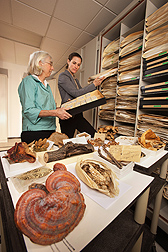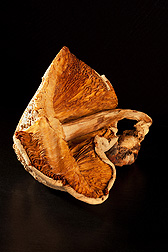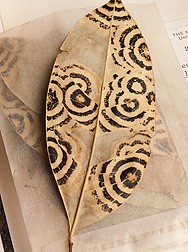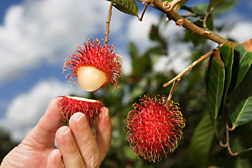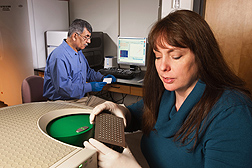Fungi Can Be Friends or Foes
Fungi are a large and diverse group of organisms. Some fungi, like mushrooms, are edible and considered crops. Others, however, can cause serious diseases of crop and forest plants, and those diseases can have negative effects on local and international economies as well as on the supply of food and other materials that agriculture provides.
The Agricultural Research Service maintains a unique resource—the U.S. National Fungus Collections—for helpful and detailed information about fungi. Accurate knowledge of fungi is critical for controlling the diseases they cause.
North America’s Largest Fungarium
In 1869, the Smithsonian Institution transferred its fungal collection to the U.S. Department of Agriculture. It later became the Mycological Collections and finally the U.S. National Fungus Collections.
“The collection had fewer than 3,000 specimens in 1885. It has grown to more than 1 million collected specimens and is the largest fungarium in North America today,” says Amy Rossman, research leader of the Systematic Mycology and Microbiology Laboratory (SMML) in Beltsville, Maryland. “It is important that this long-standing resource be available because species and science are not static, and you can never go back in time and space. Many fungal species can be lost either through competition or habitat loss, so having this collection will become increasingly important.”
|
|
When producers are faced with a fungus problem in their crops, the U.S. National Fungus Collections, its curator, and the scientists who work most directly with the collection are often the first contacts made. SMML biologist Shannon Dominick serves as the collection manager, receiving, cataloging, maintaining, and providing samples of fungi.
“When this collection was started more than 100 years ago, no one had an inkling of how DNA worked or its scientific importance,” says Dominick. “Now, DNA is extracted to definitively identify fungal species that may be new or those that have been sitting in the collection for years. It is imperative that this collection be available for future scientific technologies that may help agricultural scientists and producers maintain health of a crop.”
Protecting Turf Grass
The U.S. National Fungus Collections has come in handy for determining the fungus responsible for anthracnose disease in a turf grass used in the southern United States. Molecular biologist Jo Anne Crouch was asked to identify the fungal culprit of anthracnose disease in centipedegrass in that region of the country. While many suspected one fungus, Colletotrichum sublineola, Crouch ultimately found that a different, related fungal species, C. eremochloae, was the cause. She reported this finding in the journal Mycologia in 2012.
“DNA sequence data from modern cultures and archival fungarium specimens in this study were used to determine the identity of the fungus responsible for centipedegrass anthracnose disease and to provide confirmation of its pathogenicity,” says Crouch. “We investigated C. eremochloae based on the genetic evolutionary tree analysis and found that the isolates we obtained from centipedegrass had some physical characteristics in common with C. sublineola, but there were also distinct genetic differences.”
Indeed, there were fixed nucleotide differences between the species in collections spanning 105 years, including a specimen of C. sublineola from1904. C. eremochloae was identified from a fungarium specimen of centipedegrass in the U.S. National Fungus Collections. “Centipedegrass was first introduced to the United States in 1916 from China,” says Crouch, “and the fungus came with it.”
Now that the correct suspect has been identified, the proper fungicide can be applied to control the disease.
Fungus Invades Tropical Fruits
Another fungus has caused problems for two tropical plants—rambutan and pulasan—new crops in Honduras. Rambutan and pulasan produce edible fruits encased in coverings that have nubby or hairlike projections. A little-known fungus, Dolabra nepheliae, was discovered to cause a stem canker disease known as “corky bark” of rambutan and pulasan in Honduras.
The fungus causing this disease was identified using both microscopic structures and molecular sequence data by Rossman and her colleagues in the lab and in Honduras.
“This research will help plant pathologists to accurately identify the cause of this disease of specialty crops,” says Rossman. “It will also be used by plant pathologists and
plant quarantine officials to identify the fungi that cause diseases on these woody plants, thus helping control the spread of this disease and prevent its introduction into the United States.”
This finding was reported in the journal Plant Disease in May 2012.
Earlier research helped pave the way for this discovery. D. nepheliae belongs to a group of fungal species that cause canker diseases on woody plants such as cherry and apple trees, as well as rambutan and pulasan. Rossman and her colleagues examined hundreds of specimens and living cultures of another three genera of canker-causing fungi from around the world to determine both their macroscopic and microscopic appearance. Molecular sequence data were analyzed to evaluate the relationships among the species in the three genera. Of the 56 species included, 13 are new to science, and all are described and illustrated with a key for their identification.
|
|
“Scientists of the past documented their research with specimens and cultures. Today, these specimens and cultures are used in ways they could not have imagined,” says Rossman.—By Sharon Durham, Agricultural Research Service Information Staff.
This research is part of Plant Genetic Resources, Genomics, and Genetic Improvement (#301), Plant Diseases (#303), and Crop Protection and Quarantine (#304), three ARS national programs described at www.nps.ars.usda.gov.
Amy Rossman, Jo Anne Crouch, and Shannon Dominick are in the USDA-ARS Systematic Mycology and Microbiology Laboratory, 10300 Baltimore Ave., Bldg. 10A, Beltsville, MD 20705; (301) 504-5366 [Rossman], (301) 504-5331 [Crouch], (301) 504-6921 [Dominick].
"Fungi Can Be Friends or Foes" was published in the July 2013 issue of Agricultural Research magazine.







